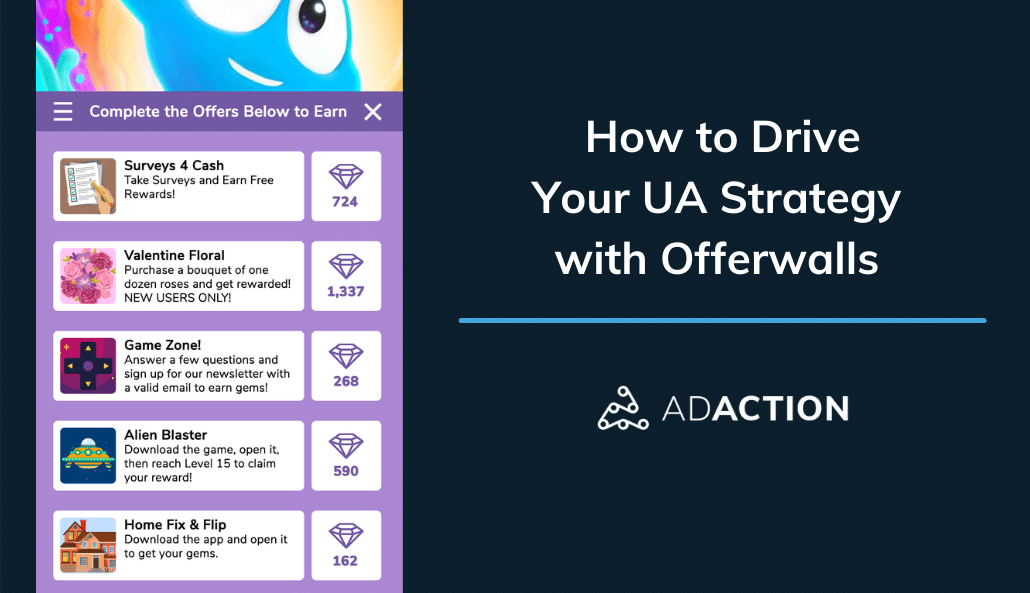Offerwalls are a favorite of mobile app marketers. They’ve got a lot going for them. They are user-initiated, so they aren’t disruptive like traditional ads. You can customize them as well, meaning they’re very versatile. In most conversations, offerwalls play a role in monetization or downstream engagement, but what about their ability to improve your UA (user acquisition) tactics? If you want to give a boost to your UA strategy, offerwalls are great fuel.
The Role of Offerwalls in UA
For any app to be successful and profitable, you must first acquire users. That includes a mix of marketing techniques, including ASO (App Store Optimization), burst campaigns, and other ad formats. All these methods can deliver results, but it’s never a bad idea to diversify your app growth strategy. Offerwalls can help you do that.
Offerwall best practices tell us that it’s a powerful vehicle for engagement and retention. Plus, industry data concludes that users acquired via offerwalls can go on to generate higher revenues.
One of the biggest reasons offerwalls make sense for UA is that you pay only for specific events, not just installs. They use CPE (cost per event) models.
These non-intrusive ad units deliver a seamless experience that can hook users and keep them on your app for years.
UA Campaign Tips Leveraging Offerwalls
Offerwalls deliver a scalable, cost-effective option for acquiring high-quality users. The keys to doing this well and consistently are:
- Increasing seasonal bids.
- Using data for optimal CPE events.
- Testing different campaigns to balance cost and engagement.
Optimizing for ROAS (return on ad spend) for each event.
Increase Seasonal Bids
Many apps employ special offerwall promotions around holidays or events. Based on historical data, the industry knows that high volume traffic is likely (think Thanksgiving afternoon while everyone’s feeling full and lazy). With the promise of traffic and an inviting offerwall promotion, you could see higher UA.
The key to capitalizing on it is raising bids during this interval. With higher bids comes higher visibility on the offerwalls. To ensure your offer gets visibility, consider raising your bids during these times.
With a featured placement and a relevant offer, users may flock to your app and stay there. Depending on your app and audience, special events can mean more than holidays. Traffic spikes from past years should inform these decisions.
Use Data for Optimal CPE Events
Your UA offerwall strategy should rely on data to identify the best CPE events for campaigns for long-term engagement and retention. There are a variety of events that could bolster UA. You simply need to follow the data.
Look at historical data around typical user engagement patterns and trends. From this, you can clearly identify the best events in the app. You’re looking for events that:
- Hook the user and result in further retention.
- Correlate with monetization of the user (i.e., in-app purchases or subscriptions).
If you boost retention and/or monetization, events will lead to higher LTVs (lifetime values) as well as ROAS. An illustrative example:
- Gameplay data tells you players are likely to remain on your app and keep playing if they reach a certain level.
- Set up your CPE campaign to drive the user to that level or beyond.
Increasing retention and/or monetization events will lead to higher LTVs and ROAS from the paid UA. An example is if gameplay data shows that a user is significantly more likely to retain and continue playing the game if they reach level 10, then set up a CPE campaign driving the user to level 10 or beyond.
Test Different Campaigns to Balance Cost and Engagement
Another aspect of UA, offerwalls, and CPE campaigns is testing. By testing multiple campaigns, you can determine which engagement events work to balance the level of cost and deep level user engagement.
The depth of engagement will impact the CPE price. If the goal is to push users to high levels in gaming or move from a free trial to paid subscription in non-gaming, the CPE cost will increase. Ideally, you want to find a nice equilibrium between cost and engagement.
Optimize for ROAS for Each Event
Every ad campaign you run should optimize for ROAS. That’s a no-brainer, but it’s a challenging thing to achieve. You can start by setting unique ROAS goals for each campaign. Campaigns can bring in variables like different events, operating systems, or geographic locations.
A strategic approach to ROAS goals is defining the volume of new users you expect or want as well as the quality and engagement of the users. For example, if you’re seeking a high volume of new users, you should prioritize top of funnel (ToFU) campaigns. Examples include installing or completing the tutorial. You could see high completions of the event, but you may not have optimal engagement.
If engagement is your priority, then you’ll focus on deep funnel campaigns. Of course, you’ll have less users that make it this far, but the ones who do are likely to remain engaged.
You’ll want to continue tweaking with bidding and campaigns to find the most optimal ROAS that meets your UA priorities.
Not All Offerwall Providers Are Equal, Select the Best Fit for Your UA Strategy
App marketers have lots of choices when it comes to offerwalls. However, they aren’t all the same. Look for one that best fits your strategic approach. Seek out one with unique user bases, standalone placement opportunities, and the ability to advertise on all platforms, including Android, iOS, mobile web, and desktop.
We invite you to explore our offerwall capabilities. Check out our infographic, 8 Reasons to Tap AdAction As Your Offerwall Provider


